There’s much more to an NPS® survey than just the quantitative rating customers give. You can keep track of your score and its changes, but it’s the qualitative feedback that gives you the “why” behind it.
Ask the right NPS question to get a constant pulse on your customer satisfaction, and you will gain an accurate understanding of how your company, product, or service is perceived. Embark on the process by determining the appropriate Net Promoter Score® survey template, and the impact will be decisive.
Just like in face-to-face conversations, the wording, tone, and phrasing of a survey question hugely impact someone’s response. Hence your choice of words has the ability to effect a change in your customers’ feedback.
In this article, we’ve listed 20 best NPS survey templates you can use to acquire meaningful insights from your customers. If you’re struggling to increase your survey response rate and get actionable feedback, try changing your main rating and open-ended questions, along with the Thank You message to one of the examples below. As a result, you will be able to reach your customers from a different angle and unlock compelling NPS data.
But first things first, so before getting to the actual survey templates, let’s do a quick recap of what an NPS survey is, its structure, and the elements shaping the NPS question wording.
What is a Net Promoter Score survey?
Generally, a Net Promoter Score survey is a simple questionnaire that aims at predicting whether a customer will repurchase from a company or refer it to someone else. NPS surveys are thus actively used to measure customer experience, customer satisfaction and loyalty to a brand, as well as its dynamic over time.
NPS survey structure
The Net Promoter Score survey consists of a two-part questionnaire. The first part asks your customers to rate – the rating question – your business, product, or service on a scale of 0 to 10. The second question is a follow-up, open-ended question as to why the specific score was given.
Since the open-ended question directly relates to the specific scoring criteria, as a rule of thumb, they need to be shaped taking into account the 3 NPS categories customers fall into: Promoters (loyal customers, your 9 and 10s), Passives (unenthusiastic customers, your 7 and 8s) and Detractors (unhappy customers, rating you in the 0 to 6 range).
The rating and the open-ended questions have a standard format that most NPS services use. However, they can be customized according to your business specifics and the goals of your NPS campaign.
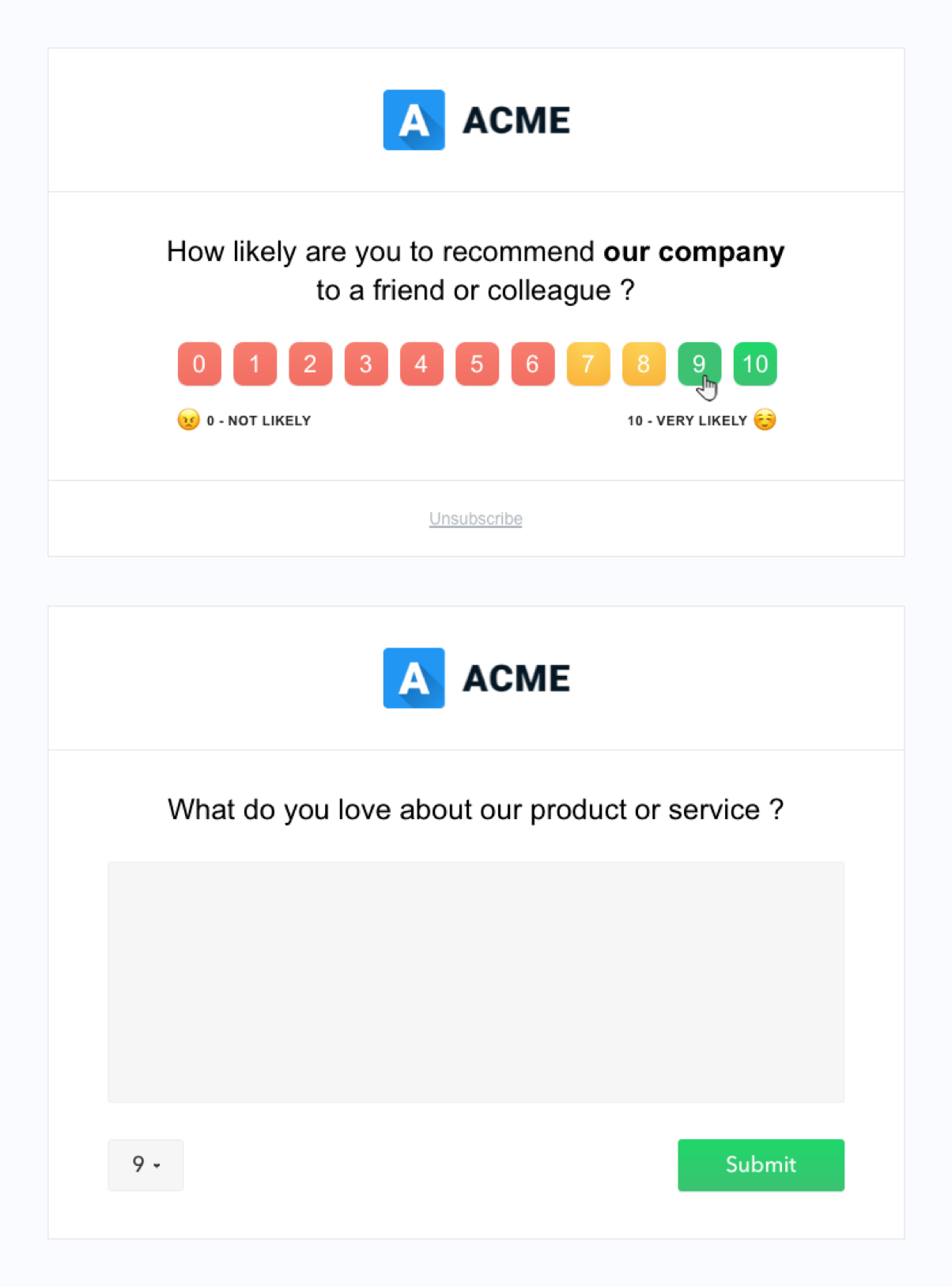
Can I add more questions to the NPS survey?
The NPS questions are short, easy, and flexible, allowing NPS surveys to offer brevity and more clarity than conventional long forms. As such, the survey results show significantly higher response rates than other survey formats, making them a more reliable method.
For more insights, you can, of course, add optional questions to the standard survey template. Specialized NPS software will offer the possibility to fully customize your survey and add more closed-ended questions (rating, multiple options, nominal) or additional open-ended questions.
However, beware! More questions do not necessarily translate into more value. Do not overwhelm customers with too many questions, especially if you are just getting started. Stick to the most important ones that would reveal the exact insights you are after.
Questions to ask in your NPS survey
Before cluttering your template with too many questions, think of the main reason for reaching out in the first place. Make sure to clearly formulate the goal of your NPS survey to be able to single out the question that will bring you the most actionable customer feedback.
Here are a few things to take into account when drafting your survey:
- targeted customer segment
- touchpoint in the customer journey
- triggering event
- behavior over time
- customer’s pain points or that one thing that could convert them into loyal enthusiasts
- survey channel
The secret of a successful NPS survey is simple: get to know your audience extremely well to be able to provide value and tailor their experience.
But let’s cut to the chase and get to the best NPS question templates that will match the different scenarios and be extremely helpful in your campaigns.
Rating survey questions
1. Ask customers to rate your company
If you’re just getting started with Net Promoter Score surveys, then it’s a good idea to use the default form of the survey question. The classic NPS question is simple:
“On a scale of 0 to 10, how likely are you to recommend our business to a friend or colleague?”
This question was designed to capture your customers’ satisfaction with your company. The benefits of asking this particular question are considerable. On the one hand, it establishes the foundation of your customer communications, offering them the opportunity to speak their minds. In this respect, your first NPS survey is the perfect icebreaker. On the other hand, the feedback you get following this question presents a consistent overview of your company, offering insights into issues across departments you might not even be aware of.
As a marketing or growth manager, you can find this question efficient for measuring customer loyalty, tracking the results of a particular marketing campaign, and transposing the collected data into a long-term growth strategy.
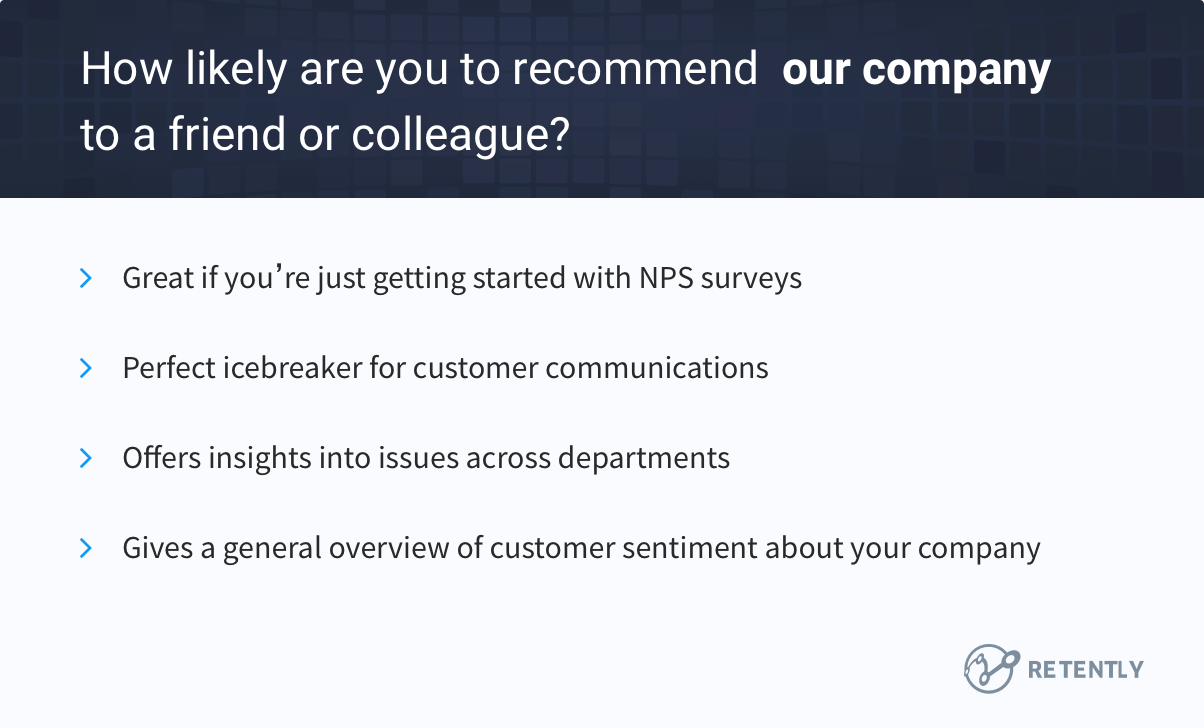
2. Replace the word “company” with a product or service
The classic NPS question is short, simple, and easy to understand. It usually brings out the type of quantitative customer ratings a business is looking for.
Despite this, it isn’t as specific as it could be. If you’re looking for feedback on a certain product or service, as opposed to the actual business, replace the word “company” with the name of the product, brand, or service.
This creates a subtle change to the question that will considerably impact results: “How likely are you to recommend (product name) to a friend or colleague?”.
Such a replacement is great for shifting the focus of the feedback from the company to the specific product you’ve just released, upgraded, or promoted. The received information is invaluable, especially for product managers, who need to consider it when working on polishing the product.
Besides, you’ll get informed of the features no longer used that have to be removed, find out about the few needing improvements, and learn about the most distinctive ones to be defined as a priority for the next product update. You’ll also acquire a genuine understanding of your customers’ sentiment in relation to your product, hence bringing more confidence to significant decisions. All in all, asking customers to rate your product is a favorable practice for successful product development.
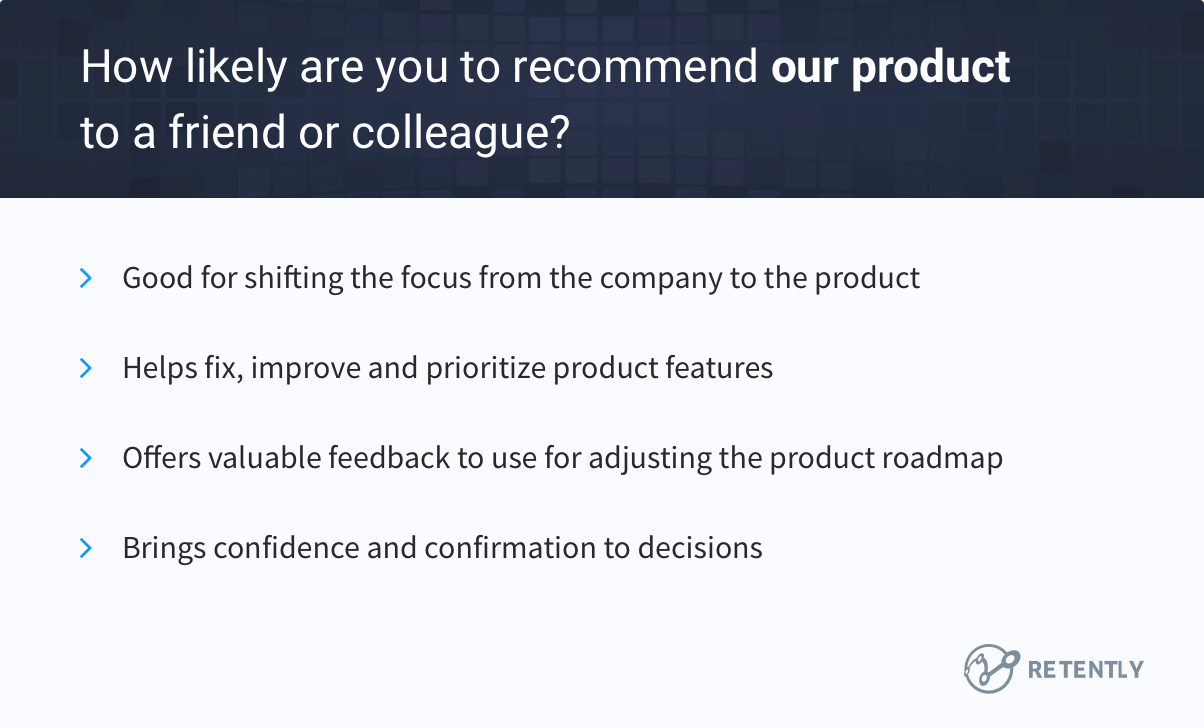
3. Ask your customers to rate a specific experience
The wording does most of the job in an NPS question. You can easily use the standard phrasing and make a few tweaks to pursue a totally different goal. You’ll be surprised at how easy it is to narrow it to a specific customer experience and bring in more context.
You can add “considering your recent experience”, “following your (type of) experience”, or “based on your latest interaction with” to the basic NPS question to measure the likelihood of recommendation right after a user got in touch with your customer support team or as soon as they received their purchase. Have a look at the examples below:
- “Following the latest feature updates, how likely are you to recommend (company/product name) to a friend or colleague?”
- “Considering your (recent) purchase experience, how likely are you to recommend (company/product name) to your friend or colleague?”
- “How likely are you to recommend (company/product name) to your friend or colleague based on your interaction with our support team?”
The question will highlight any issues that deserve immediate action in order to improve your customer satisfaction and, hence, yield more happy customers. These types of questions will be extremely helpful for assessing and improving your business processes, as well as the quality of the customer support experience.
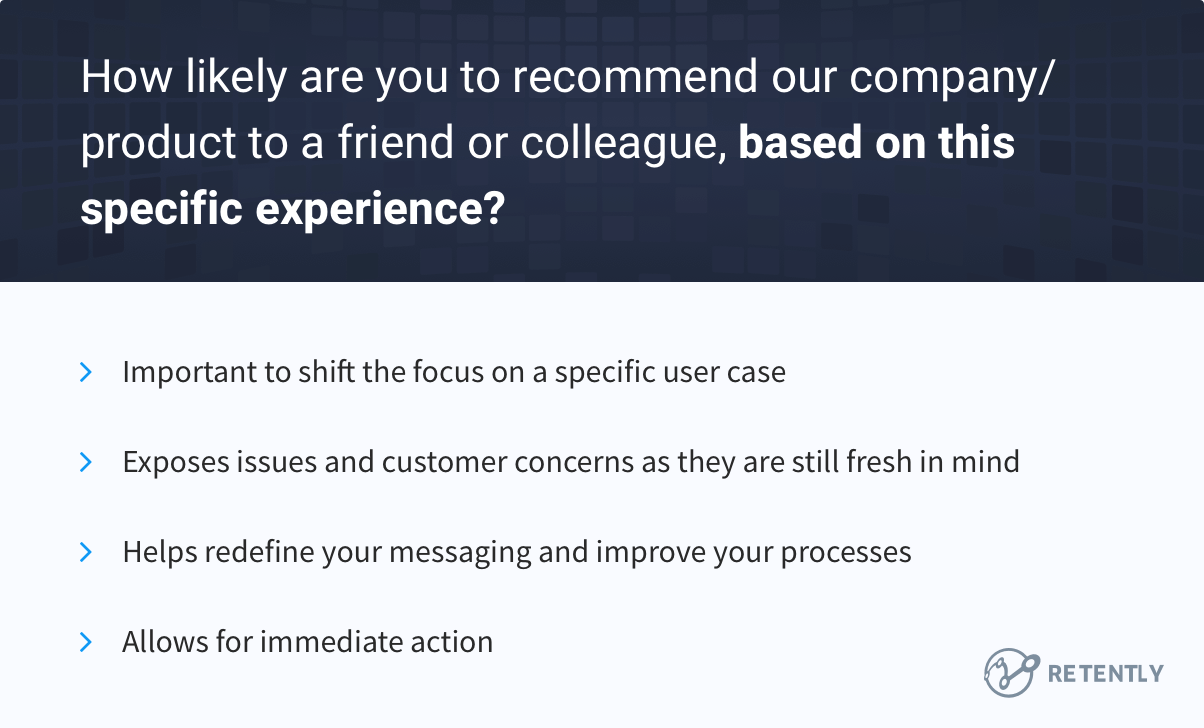
4. Replace the phrase “friend or colleague” with your target audience
Depending on your offering and the target market, you could go one step further in customizing your survey template by changing the audience, customers might refer your product or business to. Instead of the standard “friend or colleague”, consider changing the NPS question according to the examples below:
- “How likely are you to recommend (company/product name) to someone with similar business challenges?”
- “How likely are you to recommend (company/product name) to someone sharing the same interests?”
- “How likely are you to recommend (company/product name) to your family members?”
- “How likely are you to recommend (company/product name) to your circles?”
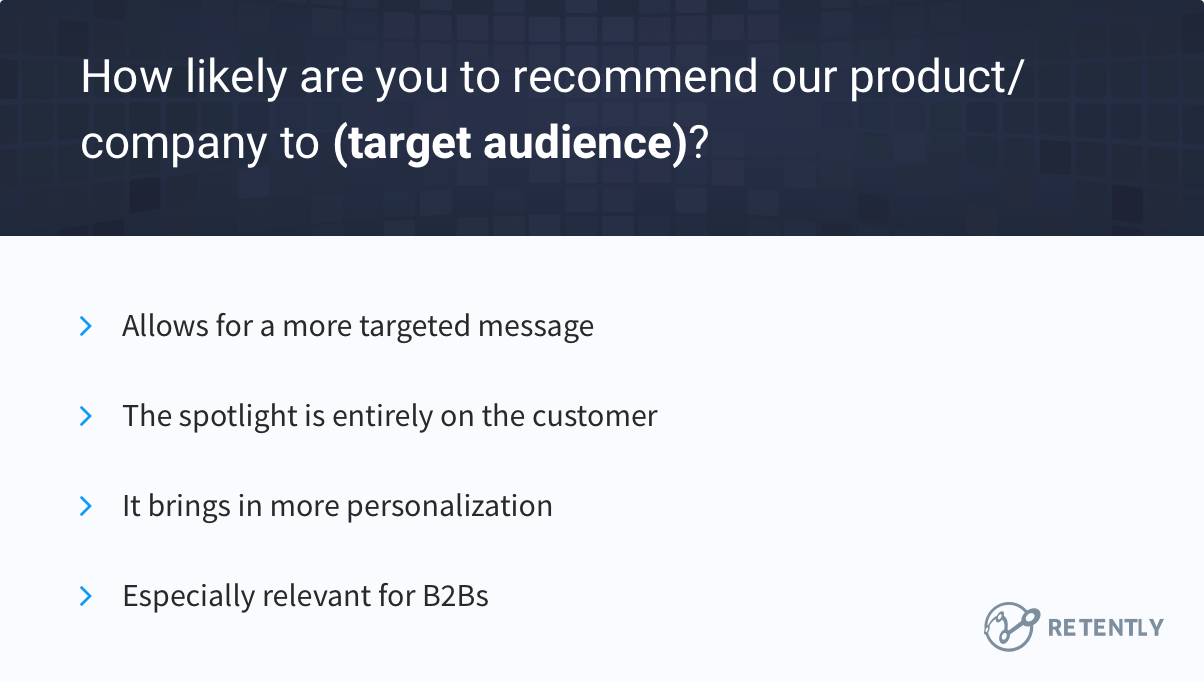
5. Find out how satisfied your employees are
Improving your customers’ satisfaction should be among your top priorities. However, another concern with a dramatic impact would be keeping your employees happy.
While the NPS survey is usually geared toward customers, being a useful source of NPS ratings for product and business services, it should also be available for employees in order to measure employee health. Satisfied personnel is the ground of a high-performance team committed to success, leading to higher profits and ensuring greater customer experience.
eNPS surveys (employee NPS) are crucial for any company because unsatisfied employees rarely speak up about major issues. This survey will expose any Detractors before it’s too late and they decide to leave your company.
eNPS will also help you identify Passive colleagues who are neither satisfied nor unhappy about their workplace, and quite likely to leave if given a better job offer at another company.
Lastly, eNPS surveys will reveal your company’s Promoters. These employees will recommend your company as a place to work at, help solve colleagues’ issues, and act as your brand ambassadors.
You can track your employee satisfaction and loyalty by asking the following question: “How likely are you to recommend (company name) as a potential workplace to your friends?”
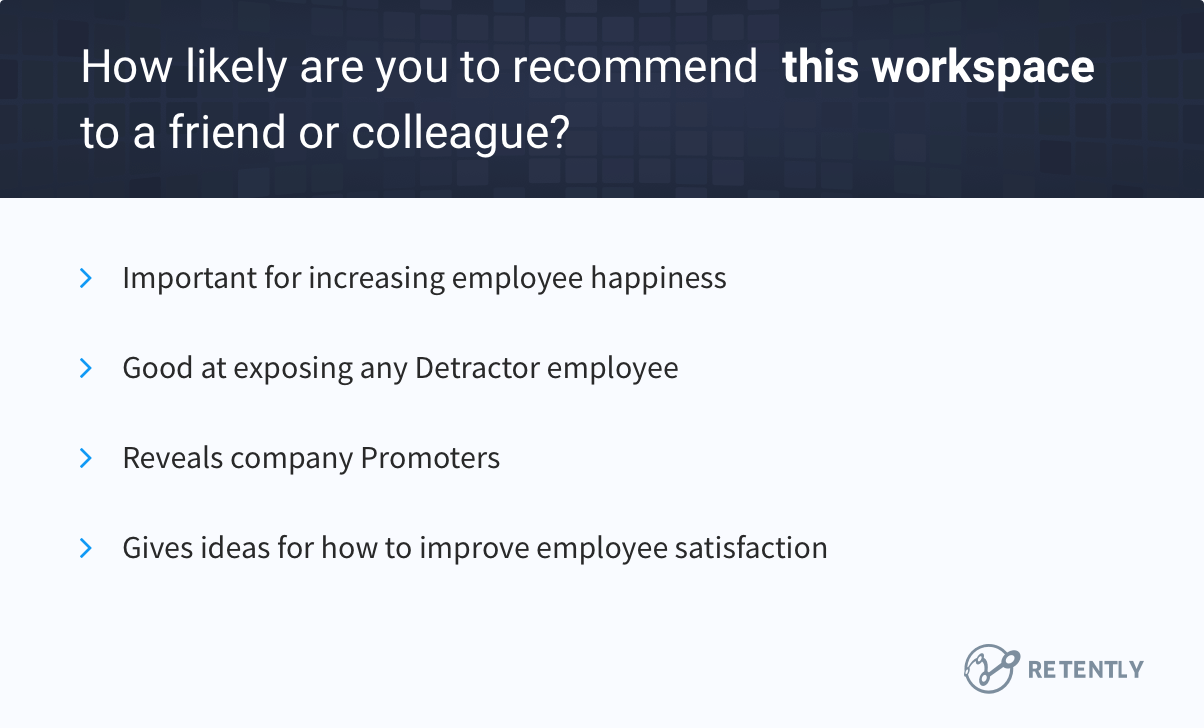
Open-Ended survey questions
Usually, NPS surveys have a standard open-ended question: “What is the primary reason for your score?”. But, we’ve noticed that customers are more likely to provide additional text feedback if the question is related to the score they just submitted.
Various NPS services allow you to personalize the open-ended question based on the score given by the respondent. Take a look at the open-ended examples below that you can use as alternatives to the standard question.
6. “What was missing or disappointing in your experience with us?”
This is a great example encouraging customers to discuss the aspects of your product or service they don’t like. Constructive criticism can be highly valuable to your business, and inviting customers to offer it makes them more likely to do so.
Many people hesitate to provide negative feedback. This question tells them that it’s okay to list any flaws they might have found when using your product, and frames the question as a way of helping you improve your service.
7. “How can we improve your experience?”
If a customer has left a Passive rating, by means of this follow-up question, you’ll get practical suggestions on what you can do to bring your product or service to the next level.
With Detractors, you’ll learn what exactly you need to do to fix errors and get your product or service back on track. You’ll be able to prioritize issues and improvement opportunities based on the information provided by your customers.
8. “Which features do you value the most?”
This question lets you gather revealing insights about which features your customers value the most. This type of campaign can be highly beneficial for product teams.
The data collected as a result of this question can be of great help in working out the features you should prioritize for future updates and improvements. As such, you can use NPS as a guiding metric when planning your product roadmap.
9. “What do you like most/least about (company or product name)?”
This question is highly useful as it allows you to get a feeling of your customers’ aftertaste following their interaction with your product or service. It’s easily customizable for both Promoters and Detractors – you can ask what they liked most or, respectively, least about their experience with your business. If you know what’s working or not for your clients, you can tweak things to serve them better.
With a sufficient amount of responses, this question can help you discover fresh angles to use in advertising and marketing campaigns, new ways to position your product, and even turn your Promoters into brand advocates. This feedback is invaluable as it directly influences your understanding of customer issues, thus giving you the proper tools to handle their expectations better.
In the case of Detractors and Passives, you’ll have specific answers as to what they don’t like about your product or company, and you will know exactly what to do to ensure a more pleasant experience for both respondent categories.
As regards Promoters, this question is efficient for generating excellent testimonials. Since you’ll get complete replies that define your product and its strengths, the feedback you get from this question is ideal for landing pages and other occurrences where customer proof is important.
Once you’ve identified the replies you can use as testimonials, reach out to respondents to ask for a photograph and their title/job role. Add these alongside each answer, and you’ll have a variety of testimonials to use for your website.
10. “How do you benefit from using our product/service?
This question may seem to mirror the two above, which is not really the case, as it exposes a different angle. Let’s assume your product is an app praised by many customers for its fast and intuitive dashboard. By replying to this question, they would explain why speed and ease of use are important to them. While for some, the variety of features would have more weight in their perception of your product, others might focus on usability aspects as a priority.
This question gives you insights about the performance of your product from another perspective. The answers to this question should be incorporated into marketing campaigns as this is exactly what potential customers are interested in.
11. “How does our product meet your needs?”
This is another way of asking whether your product is the right fit for your customers. It should be best sent to Promoters and Passives who have at least some level of satisfaction with it, unlike Detractors who haven’t apparently found what they were looking for.
The gathered feedback will help you adjust your offer and focus efforts on relevant features. Customers’ suggestions will guide your actions while designing and developing the product. In addition, you will better understand the target audience and expand your customer list based on the new insights.
12. “What problem are you trying to solve with our product?”
Each user who ends up as your customer needs your product to solve a particular problem, which differs from case to case. Getting to know the problem itself would exhibit a broad knowledge of customer expectations. Whether they are Promoters, Passives, or Detractors, customers will share common issues for their business to act upon. Asking this question is akin to market research, and, regardless of whether you did your homework before coming up with your offer or not, it will help you refine it, add new features, or maybe reshape it completely.
Detractors will likely share more insight here, as criticism is always more eloquent and elaborate.
Just like the question above, this one offers new insights about your customer base, while thorough analysis may help identify potential clients to target.
13. “Why did you opt for our product over our competition?”
Businesses always compare themselves to competitors and spend a lot of time and money adding new features to their product to make it more appealing. But what exactly do customers like about your product that made them choose you over your competitors? Is it the price, ease of use, fast shipping, variety of options, etc.? This question will help identify what exactly makes you stand out so you can further develop and harness this advantage.
It would be specifically interesting to see how Detractors respond to this one, as, apparently, even your most outstanding features are not enough to satisfy their demand. In addition, if they expand their answers, this may give you an idea of why they might switch to your competitors.
14. “What is the one thing we could do to make you happier?”
One of the most valuable things an NPS survey can offer businesses is the opportunity to close the feedback loop and delight their customers. This question is essential in showing your customers that you care about their success when using your product.
Customer Success managers can use the information provided in the answers and establish a fruitful relationship with customers. This question could be especially decisive when dealing with Detractors. By acting quickly on the feedback and offering a unique solution to your customers, you might find that it’s possible to turn your Detractors into passionate Promoters.
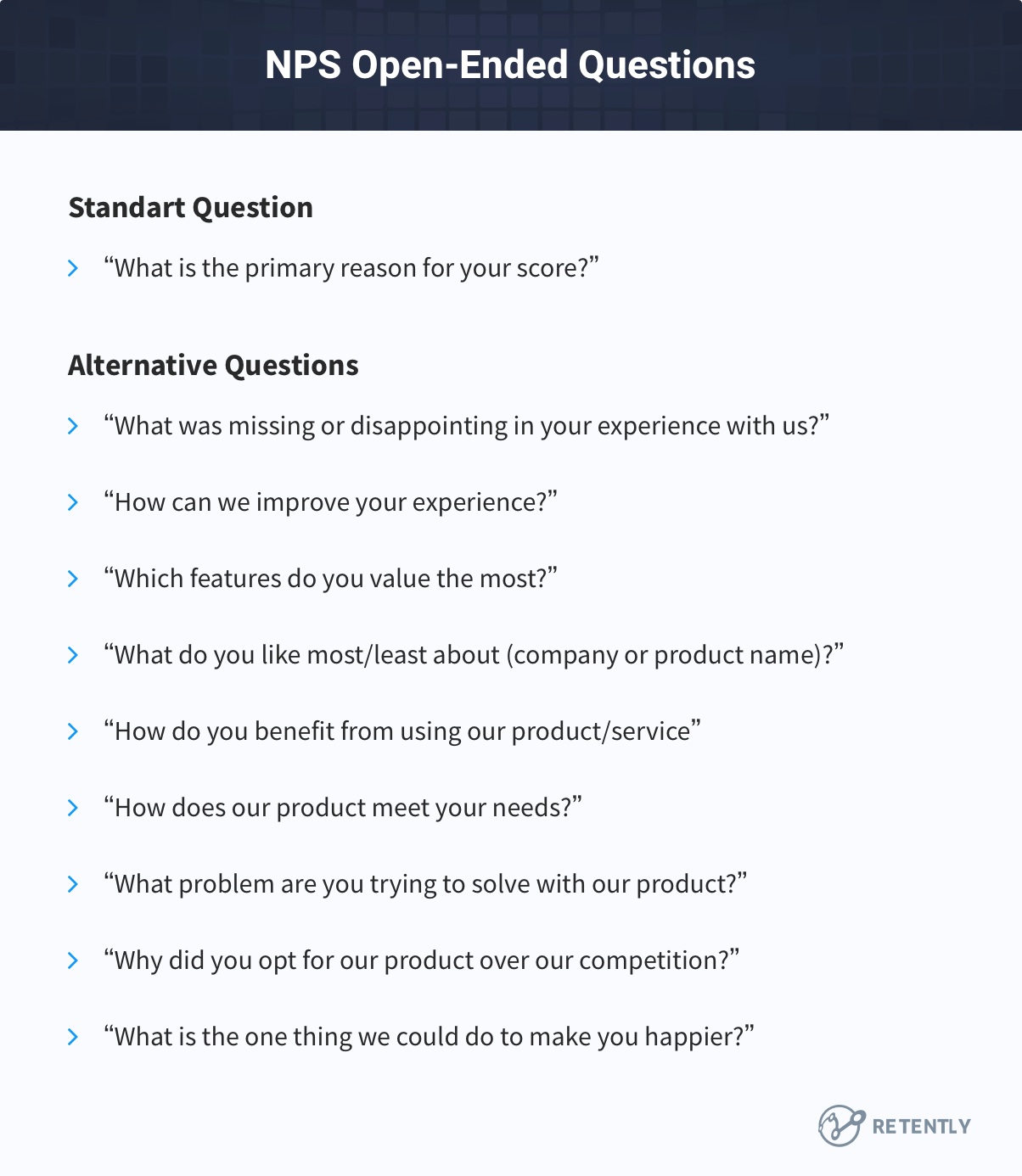
There are plenty of ways to rephrase the listed NPS questions. We have hand-picked the best ones, but you can always adjust them to better match your specific goal, the industry you are in and the target audience. You can also get instant survey questions by leveraging Retently’s survey generator. Check the below suggestions for more ideas:
- What’s the one thing we are missing in (product name)?
- What change in the (product name) would make you want to continue using us?
- What’s the next thing you think we should add/envisage?
- If you could change anything/one thing in (product name), what would it be?
- How would you feel if we took out this feature?
- If you could no longer use (product name), what functionality would you miss the most?
- What has been the main benefit to you since you subscribed to (product name)?
- What did you love most about the experience with us?
- If you could describe (product name) in 3 words, how would you do it?
- What is your favorite thing about (product name)?
- What improvements did (product name) bring to you/your work routine?
- How does (product name) help you get your job done?
- Please list 3 things that convinced you to choose us over our competition?
- What convinced you to become a paying customer?
- What was your biggest challenge when searching for the right (product type) for your business?
- What’s the one thing we can add that would make (product name) imperative/essential for you?
Thank You Messages
A Thank You message is a good way to express your gratitude to your customers. After all, they’ve taken the time to complete a survey for you, and for this, they deserve your appreciation. We’ve listed three Thank You messages below – one for each category of customers – that you can use at the end of your NPS survey.
15. Promoters – Thank you message
“Thanks for your feedback. It’s great to hear that you’re a fan of (our company or product). Your feedback helps us discover new opportunities to improve (our company or product) and make sure you have the best possible experience.”
16. Passives – Thank you message
“Thanks for your feedback. Our goal is to create the best possible product, and your thoughts, ideas, and suggestions play a major role in helping us identify opportunities to improve.”
17. Detractors – Thank you message
“Thanks for your feedback. We highly value all ideas and suggestions from our customers, whether they’re positive or critical. In the future, our team might reach out to you to learn more about how we can further improve (our product or service) so that it exceeds your expectations.”
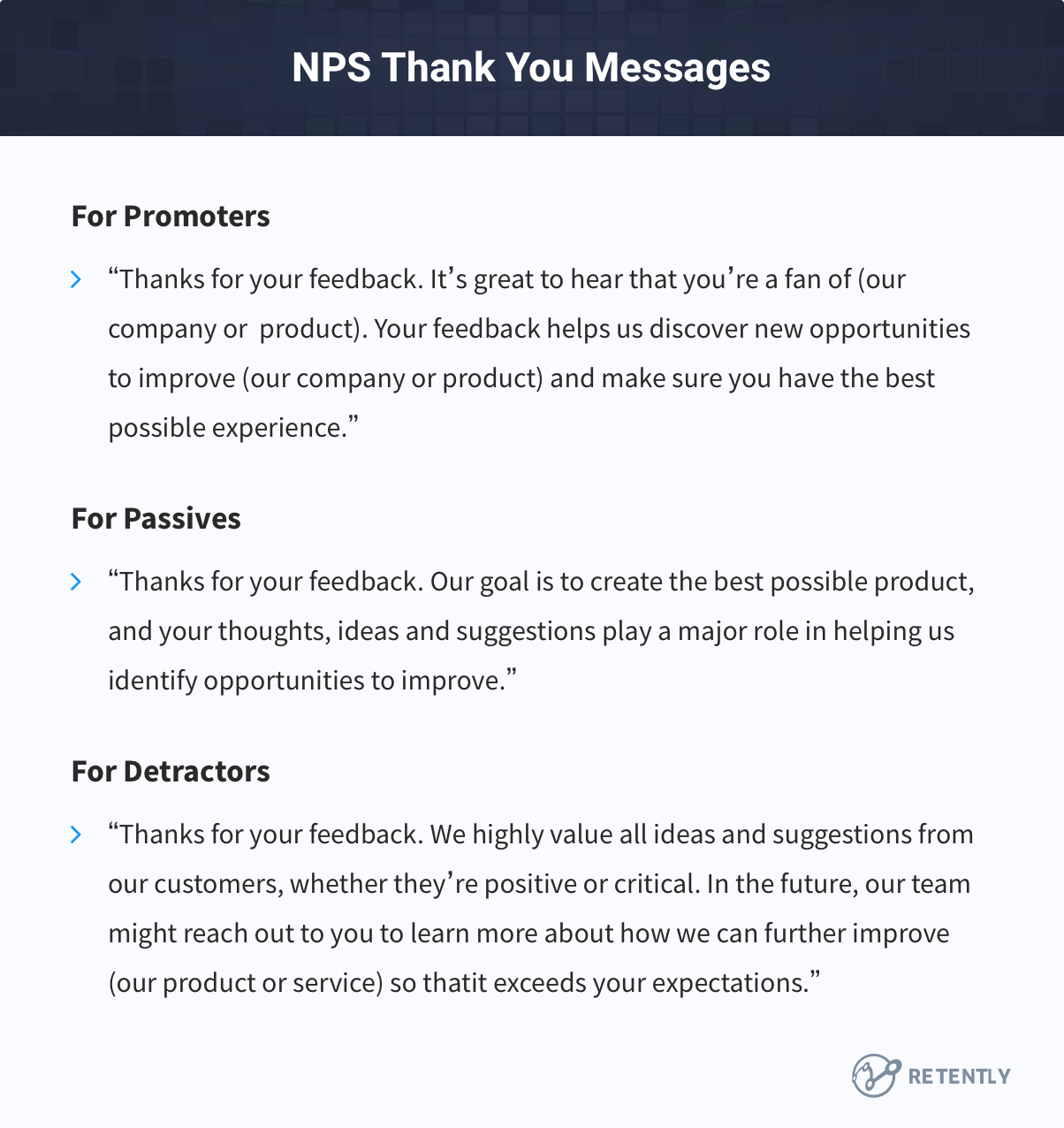
Check our article for more “Thank You for Your Feedback” response ideas.
Bonus: Post-Survey follow-up templates
It’s no novelty that customer insights are invaluable for continuously improving your product and services. Yet, manually following up with your audience at different stages of their interaction with your product could be daunting and time-consuming, especially since these need to be tailored to each customer segment. Luckily, automation is there for you to make the most of your time.
Some Customer Experience Management platforms like Retently have automation abilities offering to send automated follow-up messages when certain criteria are met. For example, you can create predefined replies that will be automatically triggered when a customer leaves a Promoter score in order to learn about your strengths and try to turn them into referrals; or when a Detractor score is submitted to enable you to act on issues you might not be aware of promptly.
Such automated follow-ups would be especially handy for e-commerce and other high-volume survey processing. High-touch B2B customers should be approached individually since generic replies would not suffice.
18. Promoters – Post-survey follow-up
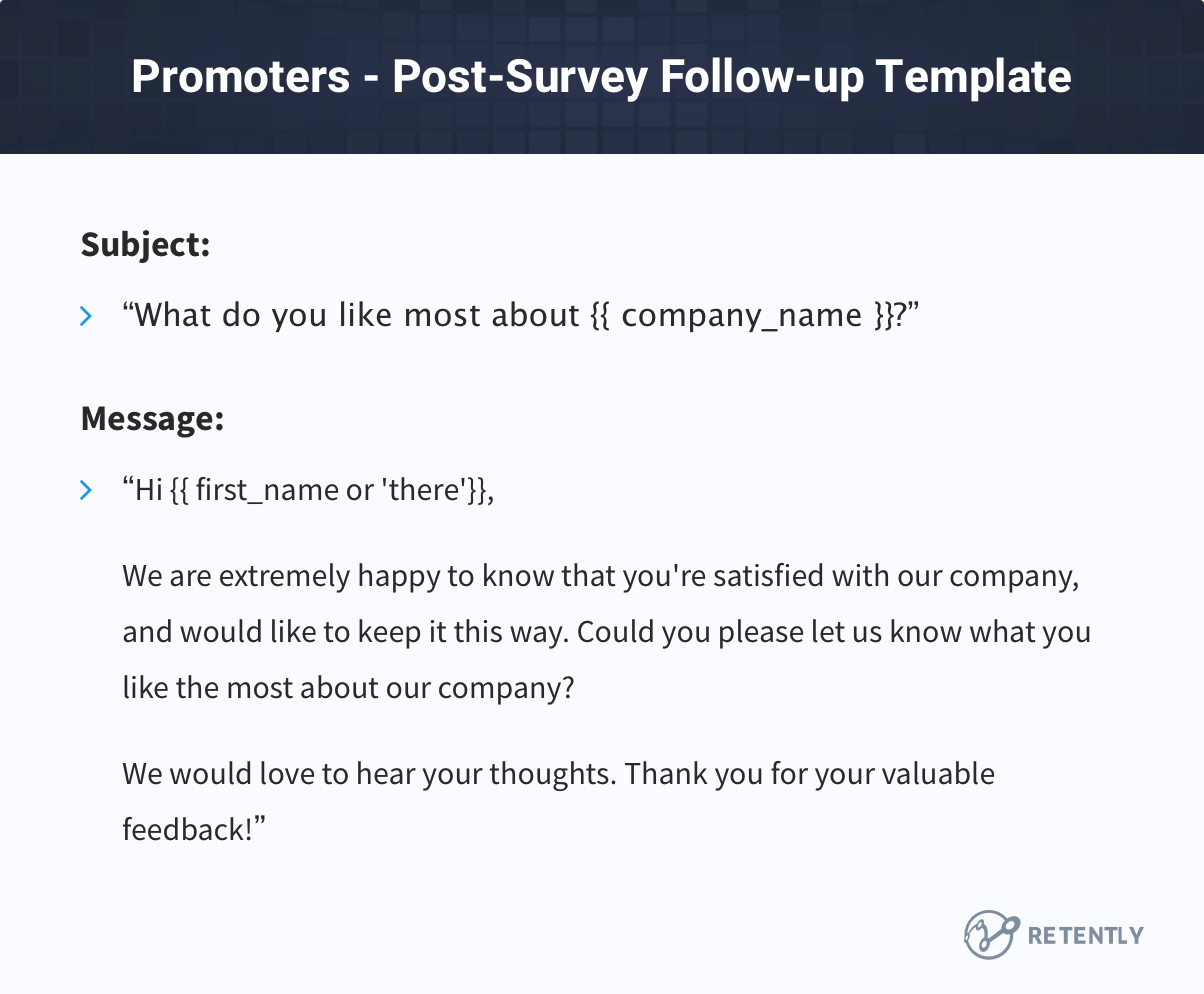
Subject: “What do you like most about {{ company_name }}?”
Message: “Hi {{ first_name or ‘there’}},
We are extremely happy to know that you’re satisfied with our company, and would like to keep it this way. Could you please let us know what you like the most about our company?
We would love to hear your thoughts. Thank you for your valuable feedback!”
19. Passives – Post-survey follow-up
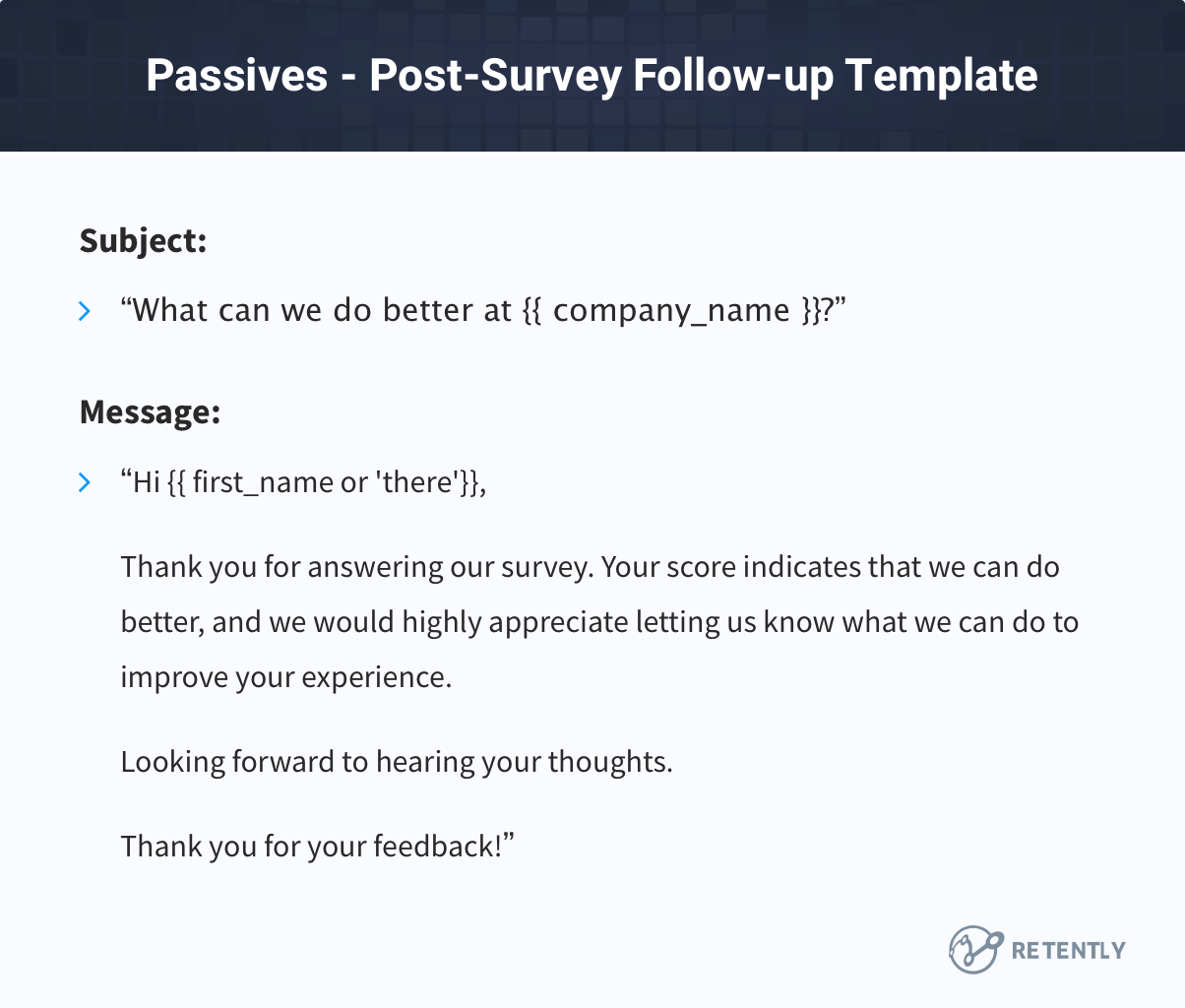
Subject: “What can we do better at {{ company_name }}?”
Message: “Hi {{ first_name or ‘there’}},
Thank you for answering our survey. Your score indicates that we can do better, and we would highly appreciate letting us know what we can do to improve your experience.
Looking forward to hearing your thoughts. Thank you for your feedback!”
20. Detractors – Post-survey follow-up
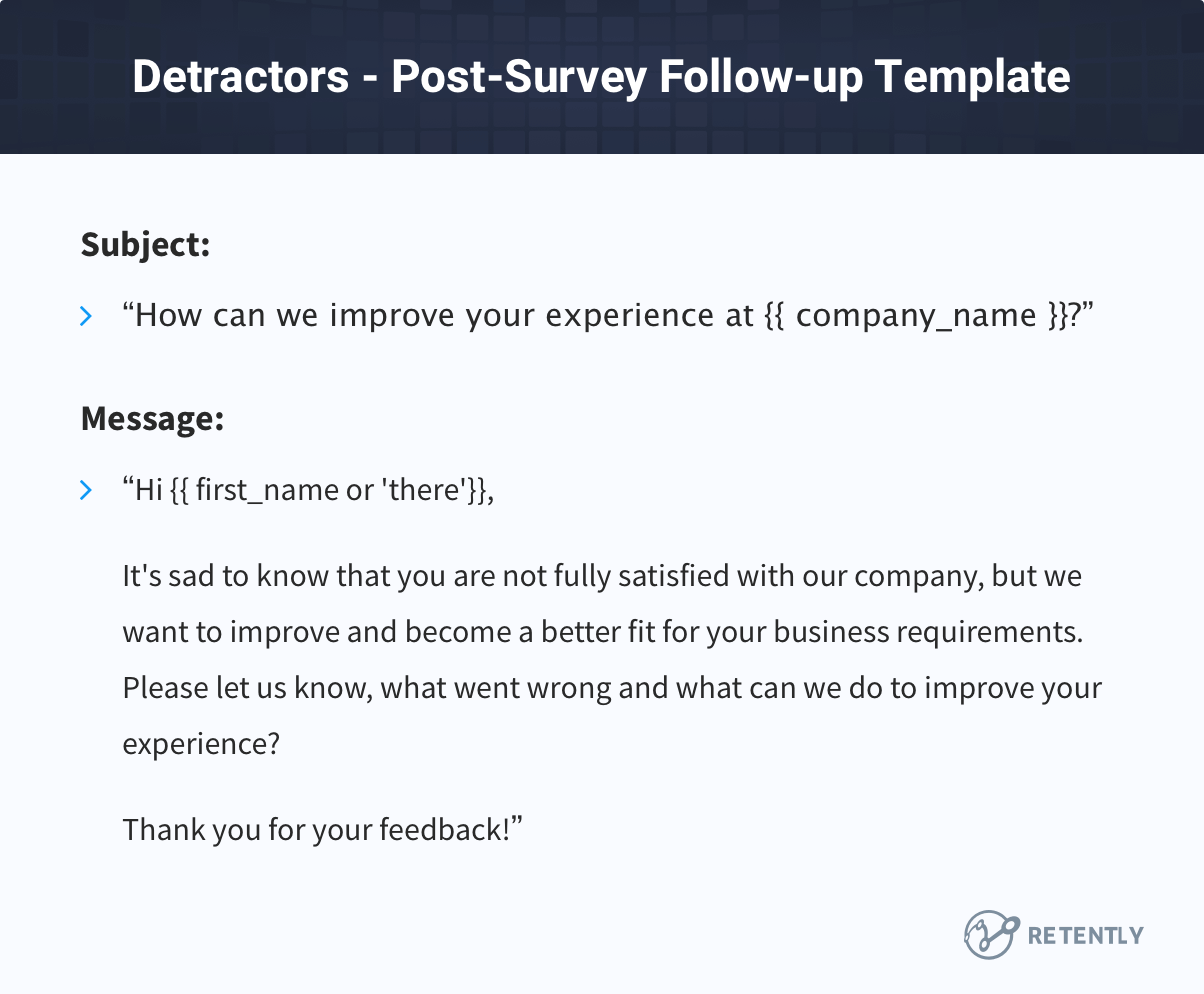
Subject: “How can we improve your experience at {{ company_name }}?”
Message: “Hi {{ first_name or ‘there’}},
It’s sad to know that you are not fully satisfied with our company, but we want to improve and become a better fit for your business requirements. Please let us know, what went wrong and what can we do to improve your experience?
Thank you for your feedback!”
How do I make a good NPS survey?
Listen and seek feedback consistently to make your customers feel involved in shaping your product or service. Personalize your survey template, target your audience rightly and make the most of the received feedback. There isn’t a one-size-fits-all NPS survey template — adjust your NPS questions with clear goals in mind and act on the received inputs towards the defined objectives.
Experiment with subject lines to stand out from the hundreds of daily emails crowding mailboxes. Engage your customers in the process with compelling headings and a personalized approach to generate detailed survey data.
Additionally, you can try segmenting your audience and running separate NPS campaigns for distinct categories of customers. For instance, you can segment your clients according to geographic information and then run an A/B test with personalized follow-up questions aiming at different customer groups. Once the feedback is in, analyze the results and determine which open-ended questions produced more replies. The better-performing questions can be used in your further NPS surveys.
From our experience here at Retently, companies practice segmentation also based on the customer lifecycle. This allows for the use of transactional NPS surveys after key events in the customer journey. Asking clients to rate their experience after they purchased a product, upgraded their plan, placed an order or canceled a subscription, etc., gives the possibility to customize the survey templates based on the subscriber’s most recent action.
Only by testing and efficiently interpreting the collected data will you be able to have a clear view of the appropriate NPS questions for your company’s purposes.
Survey your customers with Retently
Retently gives you the ability to tap into the benefits of NPS and generate customer sentiment insights. Improve client loyalty and retention while reducing churn. Sign up and start surveying your audience right away.
P.S. Got any NPS survey templates you would like us to add to the list? Leave us a comment and we’ll look at including them in this article!























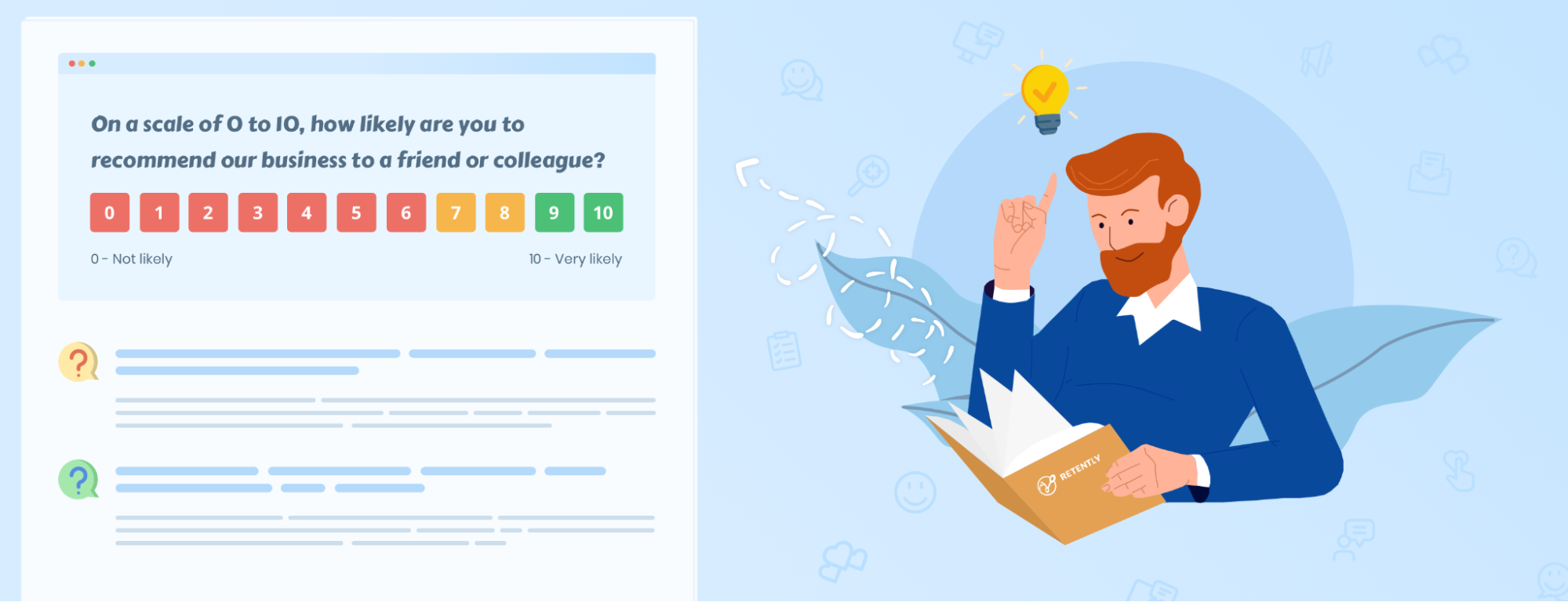






 Greg Raileanu
Greg Raileanu 

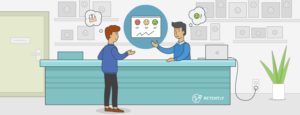

 Alex Bitca
Alex Bitca 

 Christina Sol
Christina Sol